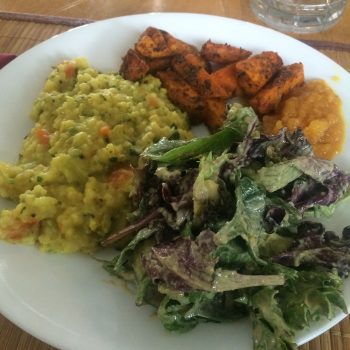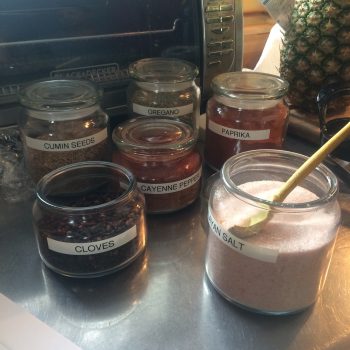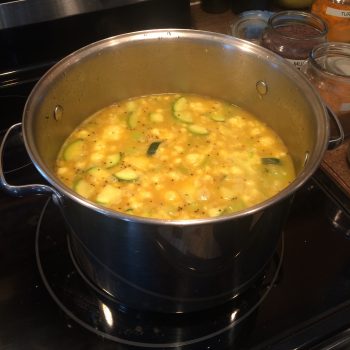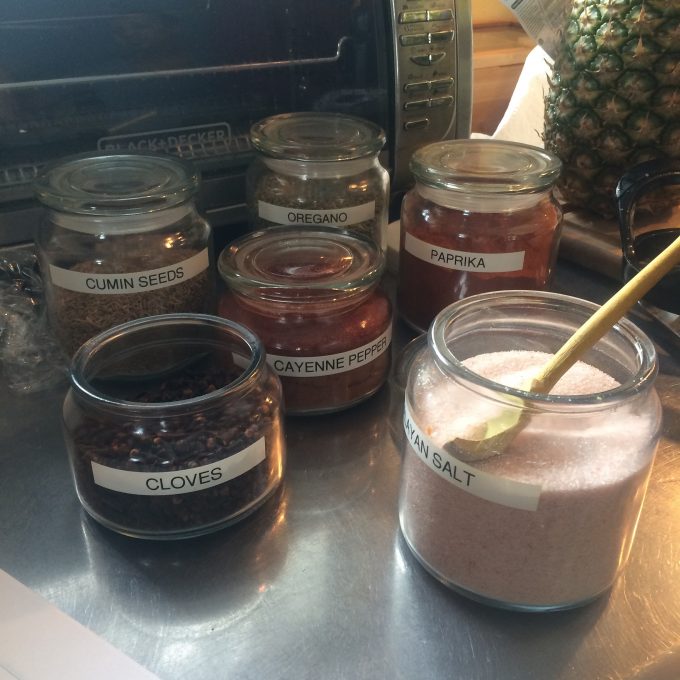Ayurveda is an ancient Indian healing tradition still recognized by the World Health Organization. I learned about it in the mid-1990s and find it more appealing as time passes. It is, after all, the “science of long life.” Ayurveda grew up alongside yoga during India’s Golden Age. It dates back at least 3,000 years, and the oral tradition may be even older. The gist of it all is that we are natural beings and, when we maintain our connection to and cooperation with nature, we maintain health and vitality. Like its homeland, Ayurveda is not strictly vegetarian but is usually so. However, ghee (clarified butter), yogurt, and milk are among the dietary recommendations. A vegan like me with an interest in this simply goes with the motto: “Take what you like and leave the rest.” With this in place, there is a great deal to like.

Certain Ayurvedic suggestions apply across the board; others are specific to one’s body type, or dosha. Some of the general recommendations are:
- Be in bed by 10 and rise around 6 a.m. to take advantage of nature’s energies that will assist you in both falling asleep and awakening with energy for the day ahead
- Upon arising, gently scrape your tongue with a silver or stainless steel tongue scraper to remove ama, metabolic debris, which has accumulated overnight on the tongue
- Drink 8 to 10 ounces of warm or hot water with a bit of lemon juice or a few drops of edible lemon essential oil (such as Young Living) to encourage a morning bowel movement
- Learn some classic yoga poses, as well as a few yogic breathing practices, and engage in these every day
- Meditate daily, or even twice daily
- Have a modest breakfast before 8:30 a.m.
- Eat your biggest meal at high noon; this is when your agni, digestive fire, is hottest
- Eat a light dinner at least three hours prior to your bedtime
- Get all six tastes — sweet, salty, bitter, pungent, sour, and astringent — in both the midday and evening meal. If you’re unsure you’ve included all of them, use chutney as a condiment; it’s designed to have all six tastes.
It gets more specific when you learn that there are three doshas, or humors, and everyone is predominately one or two of these; a few people are tri-doshic, with almost identical amounts of each dosha. The pattern you were born with is perfect for you. What happens, however, is that we stress ourselves with the wrong food (or too much food), too little sleep (or sleeping at the wrong hours), too much work or exercise (or too little exercise), and emotional stresses of various kinds. This causes one of more dosas to increase within us, perhaps Vata, which is flighty and apt to rise in anyone, whether or not Vata predominates in a particular individual. This increase leads to imbalance and excessive or persistent imbalance leads to disease.
The best dosha quiz I know of is found at https://store.chopra.com/dosha-quiz, a Deepak Chopra website. (He is also the author of my favorite book on the subject, Perfect Health.) As a brief intro:

Vata people tend to be thin, active, and cold. When in balance, they’re creative and curious, when out of balance frightened, nervous, and “spaced out.” Vata ills include digestive and nervous disorders and osteoarthritis. A couple of iconic Vatas: Audrey Hepburn and Fred Astaire.
Pitta folks are apt to be mid-sized, muscular, and the ones in the room asking if someone can open a window. If Caucasian, they tend to have a ruddy complexion, and perhaps red or reddish hair. In balance, Pittas are strong, dependable, strategic quick-thinkers with unparalleled executive ability. Out of balance, they’re angry, rude, and opinionated, and they develop inflammation-based conditions from skin rashes to acid reflex and ulcers. A Pitta in the news: Donald Trump.
Kapha men and women tend to be a bit round and a little fleshy, although they lack the voracious appetite of an unbalanced Pitta or the tendency to snack mindlessly as would a Vata who’s trying to ground herself. Kaphas aren’t crazy about exercise and it’s hard for them to get going in the morning. (Ayurveda generally warns against caffeine, but allows coffee for Kaphas; they can use the boost.) Because Kapha is slow-moving energy, people in whom it predominates are slow to become ill, although an out-of-balance Kapha is prone to respiratory infections, with or without lung involvement, and to obesity-related disorders. Kept in balance, Kapha is apt to remain healthy — and generous, kind, and good-natured — well into old age. A Kapha you recognize: Dr. Deepak Chopra.

While good health practices are good for everyone, learning your dosha and how to tweak certain foods and habits can be very helpful. For example, Vata tends to be pretty stimulated already; caffeine can put her over the edge. And since she’s already cold, making that an iced coffee would push her even further out of balance. On the other hand, a warm, creamy herbal chai made with almond milk (in Ayurveda, almonds are a specific for Vata) would be very comforting.
Pitta is hot and excitable by nature; a spicy Mexican meal with a few shots of tequila isn’t going to be best for him. However, Pitta can try all the new Ben & Jerry’s vegan flavors and stay as balanced as can be. Kapha is the master of relaxation and will get it whenever he can. Therefore, Kappa needs a bike ride or a hike on Sunday, while jittery Vata or pissed-off Pita might do well with a meditation retreat or spa day.
One easy way to help keep your constitution in balance, without feeling that you have to come up with separate meals to accommodate other family members, is to sprinkle the appropriate spices on your food at the table, the way we traditionally add pepper and salt. Blends called churnas, formulated for each dosha, are available commercially. I order mine from Maharishi Ayurvedic Products in Iowa: www.mapi.com.

Ayurveda is a lifetime study, but learning even the fundamentals can lead to improved health and an uplifted attitude. If you’re a health counselor or a vegan lifestyle coach, helping your client understand her body type and how to work with it can enable you to be of added value. In March of this year, I took an incredible weeklong training in Ayurveda at the Ayurveda Health Retreat, Alachua, Florida. In addition to learning a lot and meeting really great people, I felt a complete renewal, both physically and spiritually. I plan to return annually for panchakarma, the Ayurveda detoxification program (hint: it involves lots of massages and you don’t have to stop eating). It’s a boutique facility and because I was there, they made everything vegan for the week.
No Ayurvedic program is oil-free, however. The tradition calls for using oils — sesame and coconut are favorites — to bring out both the flavor and the healing properties of spices, and Ayurveda also teaches that for someone whose digestion isn’t strong enough to deal with raw or steamed greens or cabbage-family vegetables, cooking these in oil makes them more digestible. Ayurvedic food suggestions are also not generally compatible with all-raw diets. While Pitta people take well to cold smoothies, and Kaphas thrive on salads and crudités with dip, Vatas may want to confine these foods to summertime only, and in winter, even Pitta may feel the need for oatmeal, butternut squash soup, or rice and dal.
For me, the proof is in the proverbial pudding. When I follow the simple suggestions for overall health and the specifics for my type (I’m a Vata/Pitta), I feel better and can do more. And since I have a lot to do, I’m sticking with what enables me to do that.
Victoria Moran is the author of twelve books including Shelter for the Spirit, Younger by the Day, and Fat, Broke & Lonely No More. She is the founder of Main Street Vegan Academy and has probably read Perfect Health fifteen times. She also recommends The Ayurvedic Vegan Cookbook, by Talya Lutzker, a terrific guide for eating Ayurvedically without having to translate out the ghee in every other recipe.


Victoria, you’ve inspired me to dive back into my Ayurvedic studies! I’ve already resumed using my tongue scraper. 🙂
One note of caution–ingesting essential oils is a relatively new practice, not well studied over time, and over-ingesting may cause serious problems. A few drops of lemon juice–as you recommend in your book Younger by the Day as well as above, is preferable, in my opinion, to adding lemon essential oil on a daily basis. The Atlantic Institute of Aromatherapy can be consulted for safety reports.
I know this can be a contentious topic among essential oil aficionados; however, I tend to err on the side of caution.
Thanks for an interesting post! xo
Thank you Vicky, I agree completely on the essential oils. My daughter is into Young Living, and this is a hot topic at home. Diffuse yes, ingest no way!
Gosh, guys, I never intended to be controversial. I only put in the option for 1-2 drops of lemon oil because my Young Living consultant is adamant that it’s safe and a viable alternative to lemon juice for anyone concerned about damaging tooth enamel. I use lemon juice myself.